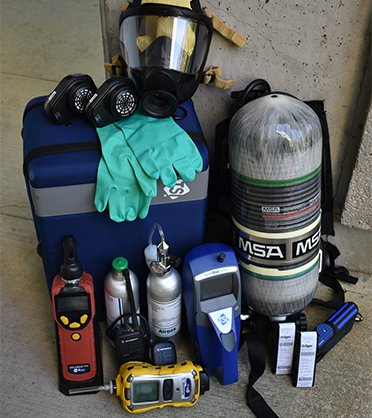Responding to oil and hazardous materials spills
Our response team is always ready to respond to incidents involving oil spills and releases of hazardous materials. The sooner we can respond, the less injury is done to Washington’s public health and safety, environment, and economy. We have teams based in Bellevue, Bellingham, Olympia, Spokane, Union Gap, and Vancouver to provide year-round, statewide, 24-hour a day response services.
Whether we are responding to chemical releases, motor vehicle accidents, grounded vessels, train derailments, or cleaning up drug labs, our top objectives are to ensure the health and safety of citizens, the environment and the economy. In Washington, we're designated to coordinate oil spills and hazardous materials response efforts by working with state agencies and local emergency response personnel on incidents that threaten or impact state waters.
New equipment grants awarded statewide
Our grants help local communities pay for equipment and training so they can quickly respond to spills of oil or other hazardous materials, as well as fires.
When incidents happen, we work to:
Control and contain the source of pollution
Controlling a spill or release can be as easy as plugging a hole in a tank, or as complex as capping an oil well on the bottom of the ocean. For spills to water we often use oil containment booms, which are floating, physical barriers made of plastic, metal, or other materials to slow the spread of oil and keep it contained.
Clean it up
One way we clean up oil spills is by using absorbent material that is oleophilic — in other words, it attracts oil but not water. This material comes in a lot of shapes and sizes including rectangular pads, long, thick sausage-like rolls, and even shredded material that looks like cheerleading pom-poms. Another device we use to cleanup spills is called a skimmer, which removes oil from the surface of the water. Companies or cooperatives with equipment and personnel that respond to oil spills, called Primary Response Contractors (PRCs), can also be hired to aid in cleanup efforts.
When spills occur, we not only clean the environment, we help harmed wildlife. Oil and hazardous materials can harm wildlife due to their harmful fumes. Wildlife can absorb these substances through their skin, consume it while feeding or grooming, or become coated or smothered by it. We work with wildlife professionals and trained volunteers to safely capture, clean, rehabilitate, and release wildlife, as diverse as birds and sea otters all the way to frogs and turtles, back into the environment.
Investigate the cause
We work with spillers to find the cause of a spill or release so we can identify things like procedure changes or equipment fixes that could help reduce the chance of another spill or release happening.
Assess natural resource damages
Whenever oil or hazardous materials are released into the environment, they cause injury to Washington's resources. Working cooperatively with spillers, as well as other federal, state, and Tribal resource trustees, we determine the extent of those impacts using a process called a Natural Resource Damage Assessment.
Restore our natural resources
Ultimately, we assess the extent of environmental impacts from the spill so we can determine what type of, and how much, restoration is needed to bring the resources back to the condition they would have been had a spill or release not occurred.
Grants for spill response equipment and training
We provide equipment cache grants to give local emergency responders the equipment and training they need to respond to spills of oil or hazardous materials.| Applicant | Award amount | Equipment or training requested |
|---|---|---|
| White Salmon Fire Department | $188,000 | Radios |
| Lummi Indian Business Council | $100,000 | Response boat |
| San Juan County Fire District 4 | $30,250 | Foam, boating safety equipment and response training |
| Swinomish Tribe | $186,400 | Safety and air monitoring equipment and response training |
| Seattle Fire Department | $247,000 | Firefighting foam accessories |
| Washington Department of Fish & Wildlife | $100,000 | Oiled mammal rescue |
| Washington Department of Fish & Wildlife | $100,600 | Response boat |
| West Pierce Fire and Rescue | $107,000 | Air monitoring, decontamination equipment |
| Stevens County Fire Protection District 5 | $377,500 | Air monitoring, hazmat response equipment and training |
| North Mason Regional Fire Authority | $12,500 | Firefighting foam and absorbent materials |
| Puget Sound Regional Fire Authority | $96,000 | Vehicle and absorbents |
| Stevenson Public Works | $96,000 | Response vehicle |
| Graham Fire and Rescue | $295,000 | Trailer for hazardous material response equipment, tow vehicle and training |
| Vancouver | $33,000 | Air monitoring equipment |
| Port of Vancouver | $41,000 | Spill response trailer |
| San Juan County Emergency Management | $17,000 | Trailer to hold oil spill containment boom |
| Pierce County Fire District 5 | $54,999 | Hazardous material identification equipment |
| Klickitat County Emergency Medical Services Dist. 1 | $26,000 | Radios |
| Spokane | $94,000 | Trailer to hold firefighting foam |
| Washington Department of Health | $17,000 | Radios |
| Mukilteo | $31,000 | All-terrain vehicle |
| Whatcom County Fire District 7 | $154,650 | Air monitoring and personal protective equipment, as well as training |
| Everett Fire Department | $85,000 | Oil spill containment boom and a tow truck |
| Samish Indian Nation | $180,000 | Spill response landing craft |
Related links
Contact information
David Byers
Response Section Manager
david.byers@ecy.wa.gov
360-790-6899


